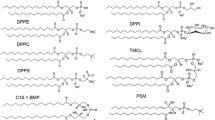Abstract
Lipid-protein films at the air-water interface were generated from a variety of native vesicles and from vesicles derived from lipid extracts. A technique is described which is particularly suitable for the generation of films from small amounts of material at high yield and velocity. In all instances, 10 μl vesicle suspensions containing 25 μg protein yield at least 50 cm2 film area at a constant surface pressure of 12 mN/m within minutes. Upon formation, surface films are separated from vesicles by use of shear forces. Complete separation is demonstrated by electron microscopy and surface pressure-area diagrams. The latter confirms previous conclusions that surface films generated from lipid vesicles are organized as a monolayer. Analysis of lipid-protein surface layers reveals that their lipid to protein ratios match those of the vesicles used, within a factor of two, irrespective of whether films are generated at high or low surface pressure. Surface denaturation of membrane proteins is shown to be effectively prevented when the film is generated and held at high surface pressure (≥ 15 mN/m). Upon surface pressure jumps from high to low values, denaturation kinetics revealed activation areas of 1.5 (±0.2) nm2.
Similar content being viewed by others
References
Dawson RMS, Hemington N, Lindsay DB (1960) The phospholipids on the erythrocyte ghosts of various species. Biochem J 77:226–230
Deters D, Müller U, Homberger H (1976) Breakage of yeast cells: large scale isolation of yeast mitochondria with a continuous flow disintegrator. Anal Biochem 70:263–267
Gaines GL (1966) Insoluble monolayers at liquid-gas interfaces. Wiley, New York, pp 44–50
Gershfeld NL (1986) Phospholipid surface bilayers at the air-water interface. Biophys J 50:457–461
Gershfeld NL (1989) The critical unilamellar lipid state: a perspective for membrane bilayer assembly. Biochim Biophys Acta 988: 335–350
Grünhagen HH (1981) Tetrodotoxin receptors in membrane fragments/purification from Electrophorus electricus electroplax and binding properties. Biochim Biophys Acta 642:267–285
Kagawa Y, Racker E (1971) Partial resolution of enzyms catalysing oxidative phosphorylation. J Biol Chem 246:5477–5487
Kates M (1975) Techniques of lipidology. In: Work TS, Work E (eds) Isolation, analysis and identification of lipids. Elsevier, New York
Kolomytkin OV (1987) Structure of planar membranes formed from liposomes. Biochim Biophys Acta 900:145–156.
Mac Ritchie F (1978) Proteins at interfaces. Adv Protein Chem 32:283–323
Mazurek N, Schindler H, Schürholz Th, Pecht I (1984) The chromolyn binding protein constitutes the Ca++ channel of basophils opening upon immunological stimulus. Proc Natl Acad Sci USA 81:6841–6845
Meissner G, Conner GE, Fleischer S (1973) Isolation of sacroplasmic reticulum by zonal centrifugation and purification of Ca2+-pump and Ca2+-binding proteins. Biochim Biophys Acta 298:246–269
Osborn MJ, Gander JE, Parisi E, Carson J (1972) Mechanism of assembly of the outer membrane of Salmonella typhimurium (Isolation and characterisation of cytoplasmic and outer membrane). J Biol Chem 247:3962–3972
Pattus F, Desnelle P, Verger R (1978a) Spreading of liposomes at the air/water interface. Biochim Biophys Acta507:62–70
Pattus F, Piovant MCI, Lazdunski CJ, Desnelle P, Verger R (1978b) Spreading of biomembranes at the air/water interface. Biochim Biophys Acta 507:71–82
Pattus F, Rothen C, Streit M, Zahler P (1981) Further studies on the spreading of biomembranes at the air/water interface: structure, composition, enzymatic activities of human erythrocyte and sarcoplasmic reticulum membrane films. Biochim Biophys Acta 647:29–39
Popot J-L, Demel RA, Sobel A, van Deenen LLM, Changeux P-P (1978) Interaction of the acetylcholine (nicotinic) receptor from torpedo marmorata electric organ with monolayers of pure lipids. Eur J Biochem 85:27–42
Salesse Ch, Ducharme D, Leblanc RM (1987) Direct evidence for the formation of a monolayer from a bilayer. Biophys J 52:351–352
Schindler H (1979) Exchange and interaction between lipid layers at the surface of a liposome solution. Biochim Biophys Acta 555:316–336
Schindler H (1980) Formation of planar bilayers from artificial or native membrane vesicles. FEBS Lett 122:77–79
Schindler H (1989) Planar lipid-protein membranes: strategies of formation and of detecting dependencies of ion transport functions on membrane conditions. Methods Enzymol 171:225–253
Schindler H, Quast U (1980) Functional acetylcholine receptor from Torpedo marmorata in planar membranes. Proc Natl Acad Sci USA 77:3052–3056
Schindler H, Rosenbusch JP (1981) Matrix-protein in planar membranes: clusters of channels in a native environment and their functional reassembly. Proc Natl Acad Sci USA 78:2302–2306
Schürholz Th, Schindler H (1983) Formation of lipid-protein bilayers by micropipette guided contact of two monolayers. FEBS Lett 152:187–190
Sobel A, Weber M, Changeux JP (1977) Large scale purification of the acetylcholine receptor protein in its membrane bound and detergent extracted forms from Torpedo marmorata electric organs. Eur J Biochem 80:215–224
Studier FW (1969) The genetics and physiology of bacteriophage T7. Virology 39:562–574
Sun ST, Milon A, Tanaka T, Ourisson G, Nakatani Y (1986) Osmotic swelling of unilamellar vesicles by the stopped-flow light scattering method. Elastic properties of vesicles. Biochim Biophys Acta 860:525–530
Szoka F, Papahadjopoulos D (1978) Procedure for preparation of liposomes with large internal aqueous space and high capture by reversed-phase evaporation. Proc Natl Acad Sci USA 75:4194–4198
Verger R, Pattus F (1976) Spreading of membranes at the air-water interface structure, composition, enzymatic activities of human erythrocyte and sarcoplasmic reticulum membrane films. Chem Phys Lipids 16:285–291
Zumbühl O, Weder HG (1981) Liposomes of controllable size in the range of 40 to 180 nm by defined dialysis of lipid/detergent mixed micelles. Biochim Biophys Acta 640:252–262
Author information
Authors and Affiliations
Additional information
Offprint requests to: H. Schindler
Rights and permissions
About this article
Cite this article
Schürholz, T., Schindler, H. Lipid-protein surface films generated from membrane vesicles: selfassembly, composition, and film structure. Eur Biophys J 20, 71–78 (1991). https://doi.org/10.1007/BF00186255
Received:
Accepted:
Issue Date:
DOI: https://doi.org/10.1007/BF00186255




